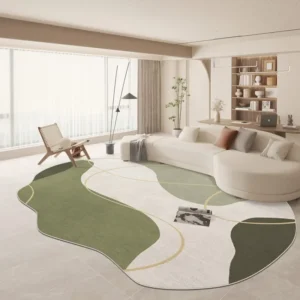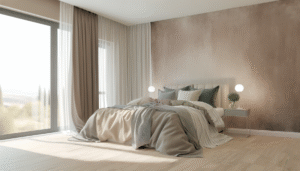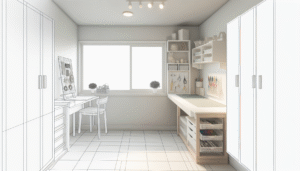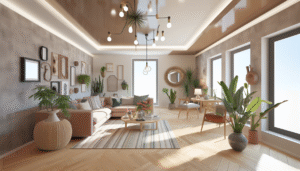
Imagine a home where every detail contributes to a sense of calm and simplicity. The Japandi style minimalist textures and fabrics create such an atmosphere, blending the tranquility of Japanese design and the functional elegance of Scandinavian aesthetics. However, many people struggle to achieve this harmony in their own spaces. This article will demystify the Japandi style and provide actionable insights on how to incorporate minimalist textures and fabrics in your home.
We will explore what Japandi style is, the core textures and fabrics used, practical tips for implementation, and real-world examples to inspire you. By the end of this article, you’ll have all the knowledge you need to transform your space into a calming oasis that reflects the principles of Japandi design.
Understanding Japandi Style
The Japandi style is a blend of Japanese and Scandinavian design philosophies, emphasizing simplicity, functionality, and natural beauty. The essence lies in creating harmonious spaces that promote tranquility.
The Origins of Japandi
This design movement draws from Japan’s minimalism and Zen philosophy, as well as the “hygge” concept from Scandinavia, which focuses on comfort and coziness. The synergy results in a uniquely adaptable aesthetic.
Core Principles of Japandi Design
- Minimalism: Less is more. Every element serves a purpose.
- Natural Materials: Wood, stone, and organic fabrics are prominent.
- Functionality: Furniture and decor must be practical yet beautiful.
- Neutral Palette: Soft tones dominate, allowing for a serene atmosphere.
Key Textures and Fabrics in Japandi Style
At the heart of Japandi style are the textures and fabrics that bring warmth and comfort to minimalist spaces. Here’s a closer look at some essential materials:
Natural Textiles
Natural fibers like linen, cotton, and wool play a significant role in Japandi design. Linen, for instance, is breathable and has a slightly rustic aesthetic that aligns with the organic feel of the style.
Wooden Elements
Wood is a staple in both Japanese and Scandinavian design. Light woods, such as beech or ash, are often utilized for furniture, creating an open, airy feel.
Stone and Ceramic
Incorporating stone or ceramic objects adds an earthy texture to the space. These materials work beautifully as decorative pieces or functional items.
Textured Wall Coverings
Consider using techniques like clay plaster or rice paper for wall finishes. These surfaces not only provide texture but also promote a sense of tranquility.
Implementing Japandi Style in Your Home
Now that we understand the core ideas behind Japandi style, let’s delve into practical ways to implement these concepts in your own spaces:
Choosing a Neutral Color Palette
Start with a neutral base. Whites, beiges, and soft greys work well as foundational colors. From here, you can use bolder accents while maintaining a calming overall look.
Selecting Furniture and Decor
Opt for furniture that blends function and aesthetics. Look for pieces that have clean lines with organic materials. Incorporate a blend of low-profile furniture for a laid-back feel.
Creating Cozy Spaces
Textures create warmth. Use throws, cushions, and rugs made from natural fibers like wool or cotton. Layer these to create depth without clutter.
Real-World Inspiration: Japandi Case Studies
To truly appreciate Japandi style, let’s examine some real-world examples and how they successfully integrate minimalist textures and fabrics:
Case Study: Zen-like Living Room
A Japanese-inspired living room featuring a low-profile couch with linen cushions, a wooden coffee table, and ceramic vases creates a tranquil environment perfect for relaxation.
Case Study: Scandinavian-Inspired Bedroom
In a Scandinavian bedroom, light wood furniture combined with a soft woolen throw and textured wall art promotes comfort and warmth, all while adhering to Japandi principles.
Frequently Asked Questions
What is the main feature of Japandi style?
The main feature of Japandi style is the harmonious blend of Japanese minimalism and Scandinavian functionality, creating serene and practical spaces.
Can I combine Japandi style with other decor styles?
Yes, Japandi is versatile and can be combined with other styles, maintaining its core principles while introducing different elements.
What materials are best for Japandi style?
The best materials include natural fibers like linen and wool, as well as wood and stone, which maintain a cohesive, organic feel.
How can I add color to a Japandi space?
Add color through art, accent pieces, or plants while maintaining the overall soothing palette typical of Japandi design.
Is Japandi style expensive to implement?
While it can be, Japandi style can be adapted to various budgets focusing on quality over quantity.
Conclusion & Next Steps
To sum up, implementing Japandi style minimalist textures and fabrics can significantly enhance the tranquility and functionality of your home. By focusing on natural materials, a neutral palette, and practical furniture choices, you can create a serene living space.
Start your journey by selecting a few key pieces that resonate with your personal style and gradually incorporate more Japandi elements. For further reading, check out our articles on minimalist decor, sustainable materials, and creating cozy spaces.
Content Disclaimer
The information provided in this article is for educational purposes only and should not be considered professional advice. Always consult relevant experts for specific guidance.
Categories
- Accent Walls & Ceilings (61)
- Art Curation & Gallery (62)
- Bedding Style Trends (68)
- Bedroom Makeover (81)
- Bohemian & Eclectic Styles (58)
- DIY & Budget-Friendly Decor (63)
- Eco-Friendly Design (62)
- Furniture Care (71)
- Home Decor & Design Ideas (163)
- Home Wellness Spaces (59)
- Integrated Outdoor Living (67)
- Japandi Style (61)
- Kids and Nursery Decor (59)
- Living Room Decor (79)
- Mix & Match Techniques (73)
- Modern & Contemporary Design (66)
- Rug Sizing & Placement (73)
- Scandinavian Design Inspiration (12)
- Seasonal Home Decor (80)
- Small Space Solutions (73)
- Wall Art & Painting Tips (77)
Recent Comments
Archives
Product Gallery
-
 Large Area Green Rugs for Bedroom Nordic Living Room Decoration Shaped Carpet Irregular Plush Lounge Rug Home Thick Washable Mat
Rated 5.00 out of 5$54.94 – $346.41Price range: $54.94 through $346.41
Large Area Green Rugs for Bedroom Nordic Living Room Decoration Shaped Carpet Irregular Plush Lounge Rug Home Thick Washable Mat
Rated 5.00 out of 5$54.94 – $346.41Price range: $54.94 through $346.41 -
 Nordic Style Rugs for Bedroom Morandi Living Room Decoration Carpet Large Area Geometry Lounge Rug Home Cloakroom Non-slip Mat
Rated 5.00 out of 5$39.46 – $597.66Price range: $39.46 through $597.66
Nordic Style Rugs for Bedroom Morandi Living Room Decoration Carpet Large Area Geometry Lounge Rug Home Cloakroom Non-slip Mat
Rated 5.00 out of 5$39.46 – $597.66Price range: $39.46 through $597.66 -
 Irregular Shapes Living Room Decoration Carpet Modern Style Rugs for Bedroom Home Thicken Plush Rug Fluffy Soft Lounge Floor Mat
Rated 4.85 out of 5$55.84 – $347.37Price range: $55.84 through $347.37
Irregular Shapes Living Room Decoration Carpet Modern Style Rugs for Bedroom Home Thicken Plush Rug Fluffy Soft Lounge Floor Mat
Rated 4.85 out of 5$55.84 – $347.37Price range: $55.84 through $347.37











